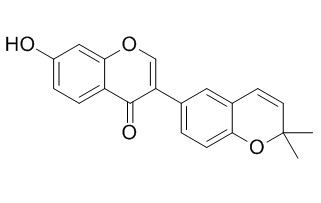Corylin
Corylin has a variety of pharmacological effects such as antioxidant, anti-proliferation, and anti-inflammatory properties, it may stimulate bone formation or have potential activity against osteoporosis. Corylin shows an inhibitory effect on IL-6-induced STAT3 promoter activity in Hep3B cells.
Inquire / Order:
manager@chemfaces.com
Technical Inquiries:
service@chemfaces.com
Tel:
+86-27-84237783
Fax:
+86-27-84254680
Address:
1 Building, No. 83, CheCheng Rd., Wuhan Economic and Technological Development Zone, Wuhan, Hubei 430056, PRC
Providing storage is as stated on the product vial and the vial is kept tightly sealed, the product can be stored for up to
24 months(2-8C).
Wherever possible, you should prepare and use solutions on the same day. However, if you need to make up stock solutions in advance, we recommend that you store the solution as aliquots in tightly sealed vials at -20C. Generally, these will be useable for up to two weeks. Before use, and prior to opening the vial we recommend that you allow your product to equilibrate to room temperature for at least 1 hour.
Need more advice on solubility, usage and handling? Please email to: service@chemfaces.com
The packaging of the product may have turned upside down during transportation, resulting in the natural compounds adhering to the neck or cap of the vial. take the vial out of its packaging and gently shake to let the compounds fall to the bottom of the vial. for liquid products, centrifuge at 200-500 RPM to gather the liquid at the bottom of the vial. try to avoid loss or contamination during handling.
Food Funct.2020, 11(2):1322-1333.
Antiviral Res.2021, 193:105142.
Asian Pac J Tropical Bio.2020, 10(6):239-247
African J. Agricultural Research 2017, 12(13):1164-1168
Food and Bioprocess Technology2017, 10(6):1074-1092
Korean Herb. Med. Inf. 2016, 4(1):35-42
Biomol Ther (Seoul).2023, 31(1):40-47.
BMB Rep.2018, 51(5):249-254
Antibiotics (Basel).2024, 14(1):8.
Natural Product Sciences2024, 30(4):309-315.
Related and Featured Products
Planta Med. 2012 Jun;78(9):903-6.
Phenolic compounds isolated from Psoralea corylifolia inhibit IL-6-induced STAT3 activation.[Pubmed:
22573369]
Inhibiting interleukin-6 (IL-6) has been postulated as an effective therapy in the pathogenesis of several inflammatory diseases.
METHODS AND RESULTS:
In this study, seven flavonoids were isolated from the methanol extracts of Psoralea corylifolia by bioactivity-guided fractionation. The structures of bakuchiol (1), bavachinin (2), neobavaisoflavone (3), corylifol A (4), Corylin (5), isobavachalcon (6), and bavachin (7) were determined by spectroscopic analysis (1H-, 13C- NMR and MS). We demonstrated that compounds 1-7 showed an inhibitory effect on IL-6-induced STAT3 promoter activity in Hep3B cells with IC50 values of 4.57 ± 0.45, 3.02 ± 0.53, 2.77 ± 0.02, 0.81 ± 0.15, 1.37 ± 0.45, 2.45 ± 0.13, and 4.89 ± 0.05 µΜ, respectively. These compounds also inhibited STAT3 phosphorylation induced by IL-6 in Hep3B cells.
CONCLUSIONS:
Overall, several flavonoids from P. corylifolia might be useful remedies for treating inflammatory diseases by inhibiting IL-6-induced STAT3 activation and phosphorylation.
Oncol Rep. 2015 Oct;34(4):2040-6.
Aqueous extract of Psoralea corylifolia L. inhibits lipopolysaccharide-induced endothelial-mesenchymal transition via downregulation of the NF-κB-SNAIL signaling pathway.[Pubmed:
26238218 ]
The epithelial-mesenchymal transition (EMT) is a pivotal event in the invasion and metastasis of cancer cells. Psoralea corylifolia L. (PC) inhibits the proliferation of various cancer cells. However, its possible role in EMT has not been identified.
METHODS AND RESULTS:
In the present study, we examined the effects of an aqueous extract of Psoralea corylifolia L. (PCAE), a typical medicinal decoction, on the EMT. Lipopolysaccharide (LPS) induced EMT-like phenotypic changes, enhancing cell migration and invasion. However, PCAE markedly reduced the expression of the LPS-induced EMT markers, including N-cadherin and vimentin, and increased the expression of β-catenin. PCAE also inhibited cell migration and invasion in vitro. The effects of PCAE on the LPS-induced EMT were mediated by the inactivation of the NF-κB-SNAIL signaling pathway.
CONCLUSIONS:
The results provide new evidence that PCAE suppresses cancer cell invasion and migration by inhibiting EMT. Therefore, PCAE is a potentially effective dietary chemopreventive agent for malignant tumors since it inhibits metastasis.
Evid Based Complement Alternat Med. 2014;2014:958937.
Comparison of the Inhibitory Potential of Bavachalcone and Corylin against UDP-Glucuronosyltransferases.[Pubmed:
24829606]
Bavachalcone and Corylin are two major bioactive compounds isolated from Psoralea corylifolia L., which has been widely used as traditional Chinese medicine for many years. As two antibiotic or anticancer drugs, bavachalcone and Corylin are used in combination with other drugs; thus it is necessary to evaluate potential pharmacokinetic herb-drug interactions (HDI) of the two bioactive compounds.
METHODS AND RESULTS:
The aim of the present study was to compare the effects of liver UDP-glucuronosyltransferase (UGT) 1A1, UGT1A3, UGT1A7, UGT1A8, UGT 1A10, and UGT2B4 inhibited by bavachalcone and Corylin. 4-Methylumbelliferone (4-MU) was used as a nonspecific "probe" substrate. Bavachalcone had stronger inhibition on UGT1A1 and UGT1A7 than Corylin which did not inhibit UGT1A1, UGT1A3, UGT1A7, UGT1A8, UGT1A10, and UGT2B4. Data fitting using Dixon and Lineweaver-Burk plots demonstrated the noncompetitive inhibition of bavachalcone against UGT1A1 and UGT1A7-mediated 4-MU glucuronidation reaction. The values of inhibition kinetic parameters (Ki) were 5.41 μ M and 4.51 μ M for UGT1A1 and UGT1A7, respectively.
CONCLUSIONS:
The results of present study suggested that there was a possibility of UGT1A1 and UGT1A7 inhibition-based herb-drug interaction associated with bavachalcone and provided the basis for further in vivo studies to investigate the HDI potential between bavachalcone and UGT substrates.



